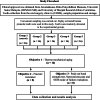Evaluation of mechanical properties of anatomically customized fiber posts using E-glass short fiber-reinforced composite to restore weakened endodontically treated premolars
- PMID: 38468269
- PMCID: PMC10926594
- DOI: 10.1186/s12903-024-04102-2
Evaluation of mechanical properties of anatomically customized fiber posts using E-glass short fiber-reinforced composite to restore weakened endodontically treated premolars
Abstract
Objective: This study was conducted to assess the influence of combining different forms of fiber-reinforced composites (FRC) on the mechanical behavior and bond strength of compromised endodontically treated teeth (ETT).
Materials and methods: Eighty extracted human premolar teeth were randomly divided into five experimental groups according to the type of intra-radicular restoration and the canal preparation design which was either non-flared (Group 1), flared (Groups 2-5), closed-apex (Groups 1,3,5) or open-apex (Groups 2,4). Standard prefabricated fiber posts were used as intra-radicular restoration for Groups 1-3 while Groups 4-5 were restored with anatomically customized relined fiber posts. After composite core fabrication, all samples were sent for an artificial aging process. Fracture resistance and push-out bond strength tests were then carried out through a universal testing machine followed by mode of failure analysis via a stereomicroscope and scanning electron microscope.
Results: Pairwise Log-Rank comparisons revealed that the survival rate of Group 2 and Group 3 was significantly lower than all other groups after artificial aging. The highest fracture resistance value (1796 N) was recorded in Group 5 and was significantly higher than that of the other groups (p < 0.05), while Group 2 exhibited the lowest fracture resistance (758 N), which was significantly lower compared to the other groups. Group 5 and Group 4 demonstrated a significantly higher push-out bond strength, at all root thirds, than Group 3, Group 2, and Group 1 (p < 0.05). The most frequently observed failure mode in the tested groups occurred between the resin cement and radicular dentin.
Conclusion: The use of short fiber-reinforced composite (SFRC) to reline the prefabricated FRC post has been proven to have superior fracture resistance with favorable failure patterns and increased push-out bond strength values compared to standard prefabricated FRC posts.
Keywords: Endodontically treated teeth; Fiber-reinforced composite Post; Post and core; Short fiber-Reinforced composite.
© 2024. The Author(s).
Conflict of interest statement
The authors declare no competing interests.
Figures







Similar articles
-
Fracture strength and nanoleakage of weakened roots reconstructed using relined glass fiber-reinforced dowels combined with a novel prefabricated core system.J Prosthodont. 2014 Aug;23(6):484-94. doi: 10.1111/jopr.12139. Epub 2014 Feb 4. J Prosthodont. 2014. PMID: 24495157
-
Fracture resistance of endodontically treated teeth restored with glass fiber reinforced posts and cast gold post and cores cemented with three cements.J Prosthet Dent. 2013 Aug;110(2):127-33. doi: 10.1016/S0022-3913(13)60352-2. J Prosthet Dent. 2013. PMID: 23929374
-
Fracture resistance of endodontically treated teeth restored with composite posts.J Prosthet Dent. 2003 Apr;89(4):360-7. doi: 10.1067/mpr.2003.75. J Prosthet Dent. 2003. PMID: 12690348
-
Surface modification of glass fiber-reinforced composite posts to enhance their bond strength to resin-matrix cements: an integrative review.Clin Oral Investig. 2022 Jan;26(1):95-107. doi: 10.1007/s00784-021-04221-y. Epub 2021 Oct 28. Clin Oral Investig. 2022. PMID: 34713360 Review.
-
Effectiveness of horizontal posts to support MOD cavities compared with other restorative approaches in endodontically treated teeth: systematic review with meta-analysis of laboratory studies.BMC Oral Health. 2025 May 21;25(1):743. doi: 10.1186/s12903-025-06022-1. BMC Oral Health. 2025. PMID: 40399871 Free PMC article.
Cited by
-
Formulation and Characterization of New Experimental Dental Composites with Zirconium Filling in Different Forms.Materials (Basel). 2024 Jun 3;17(11):2711. doi: 10.3390/ma17112711. Materials (Basel). 2024. PMID: 38893974 Free PMC article.
-
A comparative evaluation of commercially available short fiber-reinforced composites.BMC Oral Health. 2024 Dec 30;24(1):1573. doi: 10.1186/s12903-024-05267-6. BMC Oral Health. 2024. PMID: 39736654 Free PMC article.
-
Load-Bearing Capacity of Incisors Restored Using Fiber-Reinforced Composite Post-Core Systems.Dent J (Basel). 2025 Mar 13;13(3):125. doi: 10.3390/dj13030125. Dent J (Basel). 2025. PMID: 40136753 Free PMC article.
-
Comparative Evaluation of Fracture Resistance of Carbon Fiber Posts and Glass Fiber Posts in Permanent Anterior Teeth: An In Vitro Study.Cureus. 2024 May 20;16(5):e60647. doi: 10.7759/cureus.60647. eCollection 2024 May. Cureus. 2024. PMID: 38903272 Free PMC article.
-
Finite Element Analysis and Clinical Applications of Transverse Post for the Rehabilitation of Endodontically Treated Teeth.Cureus. 2024 Jul 3;16(7):e63719. doi: 10.7759/cureus.63719. eCollection 2024 Jul. Cureus. 2024. PMID: 39100057 Free PMC article.
References
-
- Grandini S, Sapio S, Simonetti M. Use of anatomic post and core for reconstructing an endodontically treated tooth: a case report. J Adhes Dent. 2003;5(3):243–7. - PubMed
-
- Grandini S, Goracci C, Monticelli F, Borracchini A, Ferrari M. SEM evaluation of the cement layer thickness after luting two different posts. J Adhes Dent. 2005;7:235–40. - PubMed
MeSH terms
Substances
LinkOut - more resources
Full Text Sources
Miscellaneous

